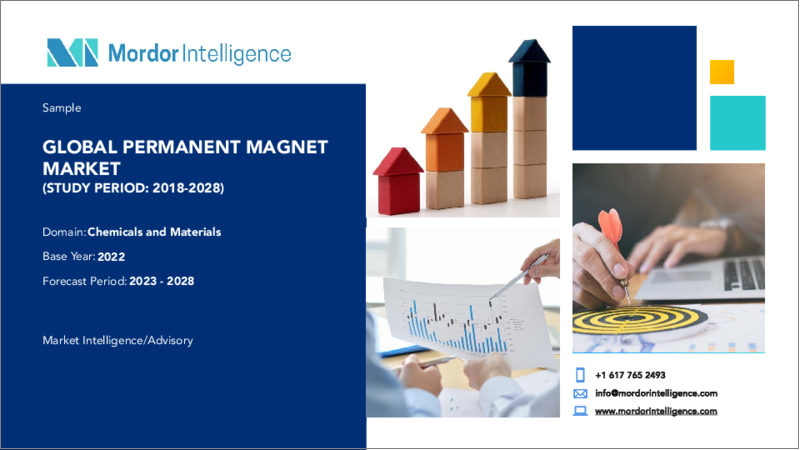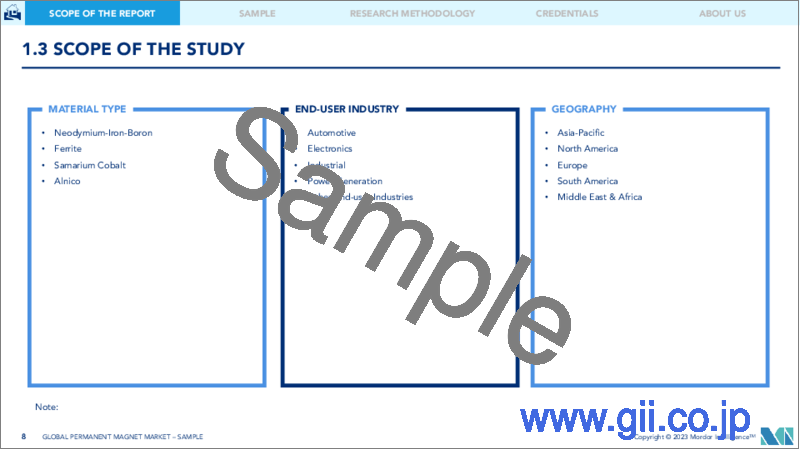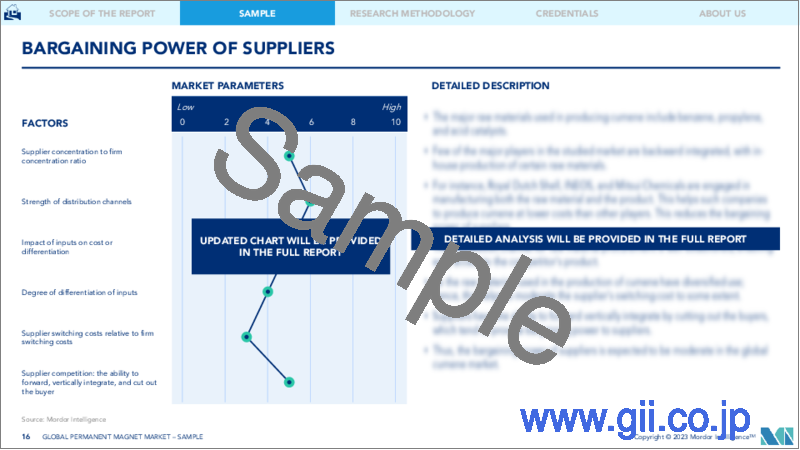|
|
市場調査レポート
商品コード
1138533
永久磁石市場- 成長、動向、予測(2022年~2027年)Permanent Magnet Market - Growth, Trends, and Forecasts (2022 - 2027) |
||||||
|
● お客様のご希望に応じて、既存データの加工や未掲載情報(例:国別セグメント)の追加などの対応が可能です。 詳細はお問い合わせください。 |
|||||||
| 永久磁石市場- 成長、動向、予測(2022年~2027年) |
|
出版日: 2022年10月13日
発行: Mordor Intelligence
ページ情報: 英文 120 Pages
納期: 2~3営業日
|
- 全表示
- 概要
- 目次
永久磁石の世界市場は、予測期間(2022-2027年)にCAGR6%超を記録すると予測されています。
市場は、新型コロナウイルスの発生によってマイナスの影響を受けました。パンデミック状況の間、自動車やエレクトロニクスなどの様々な産業は、かなり長い期間のために生産を停止しています。それが市場の成長を制限しました。しかし、2022年、状況は軌道に乗り、現在、市場は安定的に成長しています。
主なハイライト
- 中期的には、エレクトロメカニカル用途の増加が、調査対象市場の成長を促進する主要因です。
- 一方、代替品との競合が市場成長の妨げになっています。
- 予測期間中は、アジア太平洋地域が最大のシェアを占め、市場を独占するものと思われます。
主な市場動向
エレクトロニクス分野での需要拡大
- 永久磁石は、電気機械製品の効率向上のために使用されることが多くなっています。
- 永久磁石は、冷蔵庫、電気モーター、スピーカー、センサーなど、エレクトロニクス分野で幅広く使用されています。
- 電子工業は絶えず顕著な進歩および開発をし、調査される市場のための要求は急速に、育っています。携帯電話、携帯情報端末、ゲーム機、その他のパーソナル電子機器の生産は、電子部品の需要に火をつけ続け、永久磁石の需要をさらに押し上げると予想されます。
- アジア太平洋地域は、2022年に7%以上の成長を記録すると予想されています。中国、インド、日本などの国々は、世界の電子機器のトップメーカーです。
- 中国は世界市場のエレクトロニクス生産を独占しています。長年にわたって着実に増加してきた同国のエレクトロニクス生産は、最近、中国と米国の間で進行中の貿易戦争のために減速し、さまざまなエレクトロニクスメーカーが中国からアジア太平洋地域の他の国々に拠点を移すことを余儀なくされています。
- インドは2025年までに1兆米ドルのデジタル経済規模になると予想されており、インドの電子システム設計・製造(ESDM)部門は2025年までに1000億米ドルを超える経済価値を生み出すと期待されています。Make in India、National Policy of Electronics、Net Zero Imports in Electronics、Zero Defect Zero Effectなどの政策により、国内製造業の成長、輸入依存度の低下、輸出の活性化、製造業の活性化が約束されているのです。
- 欧州もまた、同地域への投資の増加により、著しい成長を遂げています。ドイツは欧州で最大の電子産業国です。ドイツ電気電子協会によると、同国の電気電子生産は2020年には約6%減少し、約1,820億ユーロになると予想されます。しかし、2021年12月のドイツ国内の電気・デジタル産業の売上高は181億ユーロとなり、2020年12月と比較して8.5%の成長率を記録しています。
- 英国は、欧州最大級のハイエンド家電製品市場であり、英国に拠点を置くエレクトロニクス企業は約18,000社にのぼります。国際貿易省によると、英国のエレクトロニクス部門は、地元経済に毎年160億ポンド(約1兆円)の利益をもたらしています。
- このような要因が、予測期間中、市場の需要に大きな影響を与えるものと思われます。
アジア太平洋地域が市場を独占
- アジア太平洋地域は、中国や日本における持続可能なエネルギー部門の高度な発展や、自動車技術部門を発展させるための継続的な投資により、市場を独占すると予想されます。
- また、アジア太平洋地域では、人口の増加や工業生産の拡大により、さまざまなエネルギー源を通じた電力の生産と需要が増加しています。このことが、さまざまな用途における永久磁石の需要を支えています。
- 世界の太陽光発電設備は、今年、来年と記録を更新し、2023年には年間200GWに達すると予想されています。中国とインドでは、化石燃料の代替よりも低コストで完成させることができる大規模プロジェクトに対する強力な政策的支援により、太陽光発電の成長が加速しています。
- インド政府は、今後10年間で設備容量を倍増させるという極めて野心的な計画を発表し、主に再生可能エネルギーの導入促進によってこれを実現するとしています。2020年4月から2021年2月までに、インドは9.7ギガワット(GW)の発電容量を導入しました。
- 国際自動車工業会(OICA)によると、中国は最大の自動車生産国です。同国だけで2021年第1四半期から第3四半期までに1,82,42,588台を生産し、世界台数の約31.86%を占めました。2021年の自動車生産台数は2,60,82,220台を占めています。
- インドのエレクトロニクス市場は、2025年までに4,000億米ドルに達すると予想されています。さらに、インドは2025年までに世界第5位の家電・エレクトロニクス産業になると予想されています。
- これらすべての要因が、予測期間中の同地域の市場成長に大きな影響を及ぼすと予測されます。
競合情勢
永久磁石の世界市場は、その性質上、断片的です。調査対象となった市場の主要企業には、日立金属株式会社、信越化学工業株式会社、TDK株式会社、大同特殊鋼株式会社、Lynas Rare Earths Ltd.などがあります(順不同)。
その他の特典。
- エクセル形式の市場予測(ME)シート
- アナリストサポート3ヶ月分
目次
第1章 イントロダクション
- 調査の前提条件
- 調査範囲
第2章 調査手法
第3章 エグゼクティブサマリー
第4章 市場の力学
- 促進要因
- エレクトロメカニカル用途の増加
- その他の促進要因
- 抑制要因
- 代替品との競合
- その他の抑制要因
- 産業バリューチェーン分析
- ポーターのファイブフォース分析
- 供給企業の交渉力
- 買い手の交渉力
- 新規参入業者の脅威
- 代替品の脅威
- 競合の度合い
第5章 市場セグメンテーション
- 材料タイプ
- ネオジム・鉄・ボロン
- フェライト
- サマリウム・コバルト
- アルニコ
- エンドユーザー産業
- 自動車
- エレクトロニクス
- 産業機器
- 発電機
- その他のエンドユーザー産業
- 地域別
- アジア太平洋地域
- 中国
- インド
- 日本
- 韓国
- その他アジア太平洋地域
- 北米
- 米国
- カナダ
- メキシコ
- 欧州
- ドイツ
- 英国
- フランス
- イタリア
- その他欧州
- 南米
- ブラジル
- アルゼンチン
- その他の南米地域
- 中東・アフリカ地域
- サウジアラビア
- 南アフリカ
- その他中東・アフリカ地域
- アジア太平洋地域
第6章 競合情勢
- M&A、ジョイントベンチャー、コラボレーション、契約
- 市場シェア(%)分析**/ランキング分析
- リーディングプレイヤーが採用する戦略
- 企業プロファイル
- Arnold Magnetic Technologies
- Bunting
- Daido Steel Co. Ltd.
- Hitachi Metals, Ltd.
- Earth-Panda Advance Magnetic Material Co.,Ltd.
- Galaxymagnets
- Lynas Rare Earths Ltd
- Shin-Etsu Chemical Co., Ltd.
- TDK Corporation
- Goudsmit Magnetics
- NingBo NingGang Permanent Magnetic Materials Co., Ltd.
第7章 市場機会と今後の動向
- 電気自動車による需要拡大
- その他のビジネスチャンス
The Global Permanent Magnet Market is projected to register a CAGR of over 6% during the forecast period (2022-2027).
The market was negatively affected by the outbreak of novel coronavirus. During the pandemic situation, various industries such as automotive and electronics have halted production for quite a long period. That restricted the growth of the market. However, in 2022, the situation is coming on track and now the market is stable and growing steadily.
Key Highlights
- Over the medium term, the increasing electro-mechanical applications are the major factor driving the growth of the market studied.
- On the flip side, competition from substitutes is hindering the growth of the market studied.
- Asia-Pacific is expected to account for the largest share and is likely to dominate the market studied during the forecast period.
Key Market Trends
Growing Demand from Electronics Industry
- Permanent magnets are increasingly being used in electro-mechanical products for better efficiency purposes.
- Permanent magnets have wide applications in electronics such as refrigerators, electric motors, loudspeakers, and sensors among others.
- The electronics industry is continuously making remarkable progress and development, and the demand for the market studied is growing, rapidly. The production of cellular phones, portable computing devices, gaming systems and other personal electronic devices will continue to spark the demand for electronic components which further is expected to boost the demand for permanent magnets.
- The Asia-Pacific market is expected to register a growth of more than 7% in 2022. Countries such as China, India, and Japan are the top manufacturers of electronics globally.
- China dominates electronics production in the global market. The country's electronics production which was steadily increasing through the years, has recently suffered from deceleration owing to the ongoing trade war between China and United States, forcing various electronics producers to shift their base from China to other countries in Asia-Pacific region.
- India is expected to have a digital economy of USD 1 trillion by 2025 and India's Electronics System Design and Manufacturing (ESDM) sector is expected to generate over USD100 billion in economic value by 2025. Several policies such as Make in India, National Policy of Electronics, Net Zero Imports in Electronics, and Zero Defect Zero Effect, offer a commitment to growth in domestic manufacturing, lowering import dependence, energizing exports, and manufacturing.
- Europe is also witnessing significant growth owing to the increasing investments in the region. Germany has the largest electronic industry in Europe. According to Germany electrical and electronic association, the country's electricity and electronic production have declined by about 6% to about EUR 182 billion in 2020. However, in December 2021, the sales of the domestic electro and digital industry in Germany amounted to EUR 18.1 billion, registering a growth rate of 8.5% compared to December 2020.
- The United Kingdom is one of the largest European market for high-end consumer electronics products, with about 18,000 UK-based electronics companies in the market. According to the Department for International Trade, the electronics sector in the United Kingdom is worth GBP 16 billion, each year, to the local economy.
- All the aforementioned factors are expected to significantly impact the demand for the market studied during the forecast period.
Asia-Pacific Region to Dominate the Market
- Asia-Pacific region is expected to dominate the market owing to the highly developed sustainable energy sector in China, and Japan coupled with the continuous investments occurring in the region to advance the automotive technology sector throughout the years.
- Additionally, the growing population and expanding industrial production activities in the Asia-Pacific region increased the production and demand for electricity through various energy sources. This, in turn, has been supporting the demand for permanent magnets in multiple applications.
- Global additions of solar PV capacity are on course to break new records both this year and next, with the annual market reaching 200 GW in 2023. Solar growth in China and India is accelerating, driven by strong policy support for large-scale projects, which can be completed at lower costs than fossil fuel alternatives.
- The Indian government announced an exceptionally ambitious plan to double installed capacity over the coming decade and to do so primarily through accelerated deployment of renewable energy. From April 2020 to February 2021, India installed 9.7 gigawatt (GW) of power generation capacity.
- According to the International Organization of Motor Vehicle Manufacturers (OICA), China is the largest producer of automobiles. The country alone produced 1,82,42,588 vehicles from Q1 to Q3 o f 2021, which accounted for about 31.86% of the global volume. The production of vehicles for 2021 accounted for 2,60,82,220 units.
- The Indian electronics market is expected to reach USD 400 billion by 2025. Additionally, India is expected to become the fifth-largest consumer electronics and appliances industry in the world by 2025.
- All the factors, in turn, are projected to have a significant impact on the market growth in the region during the forecast period.
Competitive Landscape
The global permanent magnet market is fragmented in nature. Some of the major players of the market studied include Hitachi Metals, Ltd., Shin-Etsu Chemical Co., Ltd., TDK Corporation, Daido Steel Co., Ltd., and Lynas Rare Earths Ltd., among others (not in any particular order).
Additional Benefits:
- The market estimate (ME) sheet in Excel format
- 3 months of analyst support
TABLE OF CONTENTS
1 INTRODUCTION
- 1.1 Study Assumptions
- 1.2 Scope of the Study
2 RESEARCH METHODOLOGY
3 EXECUTIVE SUMMARY
4 MARKET DYNAMICS
- 4.1 Drivers
- 4.1.1 Increasing Electro-mechanical Applications
- 4.1.2 Other Drivers
- 4.2 Restraints
- 4.2.1 Competition from Substitutes
- 4.2.2 Other Restraints
- 4.3 Industry Value Chain Analysis
- 4.4 Porter's Five Forces Analysis
- 4.4.1 Bargaining Power of Suppliers
- 4.4.2 Bargaining Power of Buyers
- 4.4.3 Threat of New Entrants
- 4.4.4 Threat of Substitute Products and Services
- 4.4.5 Degree of Competition
5 MARKET SEGMENTATION
- 5.1 Material Type
- 5.1.1 Neodymium-Iron-Boron
- 5.1.2 Ferrite
- 5.1.3 Samarium Cobalt
- 5.1.4 Alnico
- 5.2 End-user Industry
- 5.2.1 Automotive
- 5.2.2 Electronics
- 5.2.3 Industrial
- 5.2.4 Power Generation
- 5.2.5 Other End-user Industries
- 5.3 Geography
- 5.3.1 Asia-Pacific
- 5.3.1.1 China
- 5.3.1.2 India
- 5.3.1.3 Japan
- 5.3.1.4 South Korea
- 5.3.1.5 Rest of Asia-Pacific
- 5.3.2 North America
- 5.3.2.1 United States
- 5.3.2.2 Canada
- 5.3.2.3 Mexico
- 5.3.3 Europe
- 5.3.3.1 Germany
- 5.3.3.2 United Kingdom
- 5.3.3.3 France
- 5.3.3.4 Italy
- 5.3.3.5 Rest of Europe
- 5.3.4 South America
- 5.3.4.1 Brazil
- 5.3.4.2 Argentina
- 5.3.4.3 Rest of South America
- 5.3.5 Middle-East and Africa
- 5.3.5.1 Saudi Arabia
- 5.3.5.2 South Africa
- 5.3.5.3 Rest of Middle-East and Africa
- 5.3.1 Asia-Pacific
6 COMPETITIVE LANDSCAPE
- 6.1 Mergers and Acquisitions, Joint Ventures, Collaborations, and Agreements
- 6.2 Market Share (%) Analysis**/Ranking Analysis
- 6.3 Strategies Adopted by Leading Players
- 6.4 Company Profiles
- 6.4.1 Arnold Magnetic Technologies
- 6.4.2 Bunting
- 6.4.3 Daido Steel Co. Ltd.
- 6.4.4 Hitachi Metals, Ltd.
- 6.4.5 Earth-Panda Advance Magnetic Material Co.,Ltd.
- 6.4.6 Galaxymagnets
- 6.4.7 Lynas Rare Earths Ltd
- 6.4.8 Shin-Etsu Chemical Co., Ltd.
- 6.4.9 TDK Corporation
- 6.4.10 Goudsmit Magnetics
- 6.4.11 NingBo NingGang Permanent Magnetic Materials Co., Ltd.
7 MARKET OPPORTUNITIES AND FUTURE TRENDS
- 7.1 Growing Demand from Electric Vehicles
- 7.2 Other Opportunities




